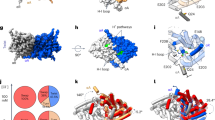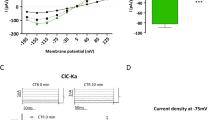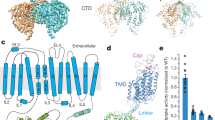Abstract
ClC-4 and ClC-5 are members of the CLC gene family1, with ClC-5 mutated in Dent's disease2, a nephropathy associated with low-molecular-mass proteinuria and eventual renal failure. ClC-5 has been proposed to be an electrically shunting Cl- channel in early endosomes, facilitating intraluminal acidification3,4. Motivated by the discovery that certain bacterial CLC proteins are secondary active Cl-/H+ antiporters5, we hypothesized that mammalian CLC proteins might not be classical Cl- ion channels but might exhibit Cl--coupled proton transport activity. Here we report that ClC-4 and ClC-5 carry a substantial amount of protons across the plasma membrane when activated by positive voltages, as revealed by measurements of pH close to the cell surface. Both proteins are able to extrude protons against their electrochemical gradient, demonstrating secondary active transport. H+, but not Cl-, transport was abolished when a pore glutamate was mutated to alanine (E211A). ClC-0, ClC-2 and ClC-Ka proteins showed no significant proton transport. The muscle channel ClC-1 exhibited a small H+ transport that might be physiologically relevant. For ClC-5, we estimated that Cl- and H+ transport contribute about equally to the total charge movement, raising the possibility that the coupled Cl-/H+ transport of ClC-4 and ClC-5 is of significant magnitude in vivo.
This is a preview of subscription content, access via your institution
Access options
Subscribe to this journal
Receive 51 print issues and online access
$199.00 per year
only $3.90 per issue
Buy this article
- Purchase on Springer Link
- Instant access to full article PDF
Prices may be subject to local taxes which are calculated during checkout



Similar content being viewed by others
References
Jentsch, T. J., Poet, M., Fuhrmann, J. C. & Zdebik, A. A. Physiological functions of CLC Cl channels gleaned from human gebetic disease and mouse models. Annu. Rev. Physiol. 67, 779–807 (2005)
Lloyd, S. E. et al. A common molecular basis for three inherited kidney stone diseases. Nature 379, 445–449 (1996)
Piwon, N., Günther, W., Schwake, M., Bösl, M. R. & Jentsch, T. J. ClC-5 Cl--channel disruption impairs endocytosis in a mouse model for Dent's disease. Nature 408, 369–373 (2000)
Wang, S. S. et al. Mice lacking renal chloride channel, CLC-5, are a model for Dent's disease, a nephrolithiasis disorder associated with defective receptor- mediated endocytosis. Hum. Mol. Genet. 9, 2937–2945 (2000)
Accardi, A. & Miller, C. Secondary active transport mediated by a prokaryotic homologue of ClC Cl- channels. Nature 427, 803–807 (2004)
Steinmeyer, K., Schwappach, B., Bens, M., Vandewalle, A. & Jentsch, T. J. Cloning and functional expression of rat CLC-5, a chloride channel related to kidney disease. J. Biol. Chem. 270, 31172–31177 (1995)
Stobrawa, S. M. et al. Disruption of ClC-3, a chloride channel expressed on synaptic vesicles, leads to a loss of the hippocampus. Neuron 29, 185–196 (2001)
Li, X., Shimada, K., Showalter, L. A. & Weinman, S. A. Biophysical properties of ClC-3 differentiate it from swelling-activated chloride channels in Chinese hamster ovary-K1 cells. J. Biol. Chem. 275, 35994–35998 (2000)
Miller, C. Open-state substructure of single chloride channels from Torpedo electroplax. Phil. Trans. R. Soc. Lond. B 299, 401–411 (1982)
Saviane, C., Conti, F. & Pusch, M. The muscle chloride channel ClC-1 has a double-barreled appearance that is differentially affected in dominant and recessive myotonia. J. Gen. Physiol. 113, 457–468 (1999)
Hebeisen, S. et al. Anion permeation in human ClC-4 channels. Biophys. J. 84, 2306–2318 (2003)
Tsai, T. D., Shuck, M. E., Thompson, D. P., Bienkowski, M. J. & Lee, K. S. Intracellular H+ inhibits a cloned rat kidney outer medulla K+ channel expressed in Xenopus oocytes. Am. J. Physiol. 268, C1173–C1178 (1995)
Friedrich, T., Breiderhoff, T. & Jentsch, T. J. Mutational analysis demonstrates that ClC-4 and ClC-5 directly mediate plasma membrane currents. J. Biol. Chem. 274, 896–902 (1999)
Dutzler, R., Campbell, E. B. & MacKinnon, R. Gating the selectivity filter in ClC chloride channels. Science 300, 108–112 (2003)
Estévez, R., Schroeder, B. C., Accardi, A., Jentsch, T. J. & Pusch, M. Conservation of chloride channel structure revealed by an inhibitor binding site in ClC-1. Neuron 38, 47–59 (2003)
Traverso, S., Elia, L. & Pusch, M. Gating competence of constitutively open CLC-0 mutants revealed by the interaction with a small organic inhibitor. J. Gen. Physiol. 122, 295–306 (2003)
Bauer, C. K., Steinmeyer, K., Schwarz, J. R. & Jentsch, T. J. Completely functional double-barreled chloride channel expressed from a single Torpedo cDNA. Proc. Natl Acad. Sci. USA 88, 11052–11056 (1991)
Weinreich, F. & Jentsch, T. J. Pores formed by single subunits in mixed dimers of different CLC chloride channels. J. Biol. Chem. 276, 2347–2353 (2001)
Chen, T.-Y. Structure and function of CLC channels. Annu. Rev. Physiol. 67, 809–839 (2005)
Van Dyke, R. W. & Belcher, J. D. Acidification of three types of liver endocytic vesicles: similarities and differences. Am. J. Physiol. Cell Physiol. 266, C81–C94 (1994)
Hara-Chikuma, M., Wang, Y., Guggino, S. E., Guggino, W. B. & Verkman, A. S. Impaired acidification in early endosomes of ClC-5 deficient proximal tubule. Biochem. Biophys. Res. Commun. 329, 941–946 (2005)
Hara-Chikuma, M. et al. ClC-3 chloride channels facilitate endosomal acidification and chloride accumulation. J. Biol. Chem. 280, 1241–1247 (2005)
Chandy, G., Grabe, M., Moore, H.-P. H. & Machen, T. E. Proton leak and CFTR in regulation of Golgi pH in respiratory epithelial cells. Am. J. Physiol. Cell Physiol. 281, C908–C921 (2001)
Holroyd, C., Kistner, U., Annaert, W. & Jahn, R. Fusion of endosomes involved in synaptic vesicle recycling. Mol. Biol. Cell 10, 3035–3044 (1999)
Bayer, M. J., Reese, C., Buhler, S., Peters, C. & Mayer, A. Vacuole membrane fusion: V0 functions after trans-SNARE pairing and is coupled to the Ca2+-releasing channel. J. Cell Biol. 162, 211–222 (2003)
Lorenz, C., Pusch, M. & Jentsch, T. J. Heteromultimeric CLC chloride channels with novel properties. Proc. Natl Acad. Sci. USA 93, 13362–13366 (1996)
Lin, Y. W., Lin, C. W. & Chen, T. Y. Elimination of the slow gating of ClC-0 chloride channel by a point mutation. J. Gen. Physiol. 114, 1–12 (1999)
Gründer, S., Thiemann, A., Pusch, M. & Jentsch, T. J. Regions involved in the opening of CIC-2 chloride channel by voltage and cell volume. Nature 360, 759–762 (1992)
Estévez, R. et al. Barttin is a Cl- channel β-subunit crucial for renal Cl- reabsorption and inner ear K+ secretion. Nature 414, 558–561 (2001)
Jurman, M. E., Boland, L. M., Liu, Y. & Yellen, G. Visual identification of individual transfected cells for electrophysiology using antibody-coated beads. Biotechniques 17, 876–881 (1994)
Acknowledgements
We thank L. Elia for technical assistance, T. Jentsch and A. Zdebik for providing the ClC-0, ClC-1, ClC-2(Δ16–61), ClC-3, ClC-4, ClC-Ka, barttin and ClC-5 cDNAs, E. Gaggero and G. Gaggero for constructing the high-impedance amplifier, and G. Gaggero for help in constructing the measuring chamber. Financial support by Telethon Italy and the Italian Research Ministry is gratefully acknowledged.
Author information
Authors and Affiliations
Corresponding author
Ethics declarations
Competing interests
Reprints and permissions information is available at npg.nature.com/reprintsandpermissions. The authors declare no competing financial interests.
Rights and permissions
About this article
Cite this article
Picollo, A., Pusch, M. Chloride/proton antiporter activity of mammalian CLC proteins ClC-4 and ClC-5. Nature 436, 420–423 (2005). https://doi.org/10.1038/nature03720
Received:
Accepted:
Issue Date:
DOI: https://doi.org/10.1038/nature03720
This article is cited by
-
Functional and clinical studies reveal pathophysiological complexity of CLCN4-related neurodevelopmental condition
Molecular Psychiatry (2023)
-
Proton-gated anion transport governs macropinosome shrinkage
Nature Cell Biology (2022)
-
Novel CLCN4 variant associated with syndromic X-linked intellectual disability in a Chinese girl: a case report
BMC Pediatrics (2021)
-
CmCLCa Plays a Key Role in the Storage of Nitrate in Chrysanthemum Leaf Vacuoles
Journal of Plant Growth Regulation (2021)
-
Dent disease: classification, heterogeneity and diagnosis
World Journal of Pediatrics (2021)
Comments
By submitting a comment you agree to abide by our Terms and Community Guidelines. If you find something abusive or that does not comply with our terms or guidelines please flag it as inappropriate.



